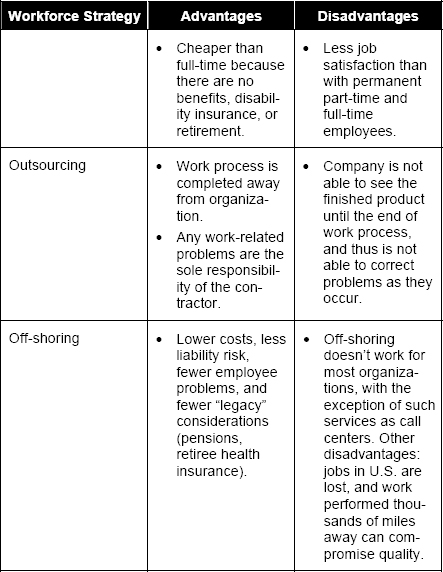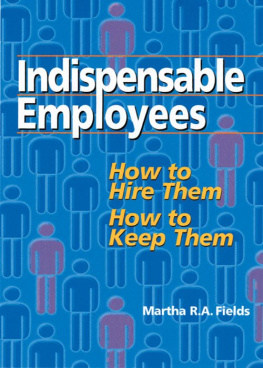HR Skills Series
Alternative
Workforce
Strategies
Peter R. Garber
HRD Press, Inc. Amherst Massachusetts
Copyright 2008, HRD Press, Inc.
Published by: HRD Press, Inc.
22 Amherst Road
Amherst, MA 01002
800-822-2801 (U.S. and Canada)
413-253-3488
413-253-3490 (fax)
www.hrdpress.com
All rights reserved. Printed in the United States of America. No part of this material may be reproduced or utilized in any form or by any means, electronic or mechanical, including photocopying, recording, or by any information storage or retrieval system, without written permission from the author.
ISBN: 978-1-59996-114-9
Production services by Jean Miller
Cover design by Eileen Klockars
Editorial services by Suzanne Bay
About the HR Skills Series
The changes that todays organizations are being forced to make to compete in the global economy present a real challenge to managers, supervisors, and HR professionals:
How can you plan for and manage changes in such areas as consumer demand, workforce turnover, production, and performance standards?
This HR Skills Series has been designed to serve as a handy informational resource on a variety of topics, managers deal with on a daily basis. Each book in the series contains background information to help decision makers familiarize themselves and their staff members with a broad topic before they make recommendations or decisions that affect the organizations bottom line, short- and long-term.
The books can be circulated among various members of a team or department so that everyone can quickly research and consider important options before providing feedback, making recommendations, or taking action. They can also be used for training or general review of key management topics.
Make sure everyone in the organization has access to the entire HR Skills Series so they can meet HRD challenges head-on.
T he complexity of todays business world requires employers to consider a variety of strategies when it comes to finding workers to fill job openings. As the needs of your business change, so too must your approach to finding and selecting new workers. How long will you need them? How much can you pay them? And can you even attract them if you cant offer permanent full-time positions?
Identifying the best employment strategy to meet your business objectives can be a big challenge. There are a variety of arrangements and services that can solve your worker shortage. This book is designed to help you better understand and identify the options and strategies that might meet your needs now or in the future. The book describes various alternatives to the traditional model of hiring permanent workers, and presents real-life situations in which specific workforce strategies have been used effectively.
Workforce Options
T he traditional employment model where workers spend most or all of their working years with the same employer is quickly being replaced by new models that more accurately reflect todays economic realities. No longer is it a certainty that an individual can hold a job for as long as he or she wants it. There are countless alternative employment arrangements that provide cheaper and more efficient ways for organizations to meet their labor needs.
The old model is not cost-effective, because when a permanent employee cannot fulfill the requirements of their job for a length of time, for whatever reason, the employer still has to keep them on the payroll and provide benefits if they want them back on the job. This responsibility represents huge expenditures for organizations that can quickly erode profit margins. Shorter-term or alternative-workforce arrangements can reduce these costs. They represent attractive options for many organizations.
Different Ways of Getting the Work Done
Lets take a look at the five major categories of workforce alternatives in detail.
Contract employees. A contract employee is an individual who works for a company that specializes in providing employees to other organizations. These contract employment agencies employ the workers and send them to other companies to work. The workers work for the agency and all employment matters are handled by the agency: hiring, disciplining, training, counseling, compensating, and so on. The organization using these services has virtually no liability for these workers; it simply pays a negotiated fee to the contract agency, which in turn pays the workers a set hourly rate.
In some cases, the contract agency also provides on-site supervision for these workers at the organizations workplace. This becomes an important factor in determining who is legally responsible. If the organization itself provides supervision for these contracted workers rather than the contract agency, it can be considered a co-employee arrangement whereby the organization assumes certain legal liabilities for these workers. If you are considering the hiring of contract workers, discuss the possibility with your legal counsel to make sure that you know who will be liable for and to go over any rules concerning the number of hours that contracted employees can be employed at another organization that will affect the pension benefits you offer your permanent employees.
Such contract or agency employees can be brought in for one day or one year or longereven permanently.
Part-time employees. The organization can bring in part-time help or even casual labor (generally on an as-needed basis). Such employees work fewer hours than do full-time employees and have no job security. They typically do not receive any health or medical benefits, thus reducing the cost to the company or organization. Part-time employees can also be provided by a contract agency.
Temporary employees. These workers may be employed by the organization or through a contract agency, hired only for the duration of a special project or for a specific period of time. In most cases, they do not receive health or pension benefits. Once the need for these workers is over, their employment ends. If they are employed by a contract service, they are simply reassigned to another company.
Outsourced services. Outsourced workers provide services off-site, away from the employing organization (sometimes in another country). Perhaps the work itself was previously performed by employees of the organization on-site. In these situations, the organization probably has little or no direct contact with the workers who are now performing this work. If it is contracted out, the contract organization has full responsibility for the work or service.
Off-shoring. This option has become a more and more popular way to reduce labor costs in the U.S. Many organizations have no choice if they want to survive economically: They must move work or services to other countries where labor costs are significantly lower than in the United States.
Each of the options has pluses and minuses. Well explore the advantages and disadvantages in this book.



Other Considerations
There are a number of other considerations that all need to be reviewed before you make a decision concerning what type of workforce alternative might be best for your organization and situation.
Next page







